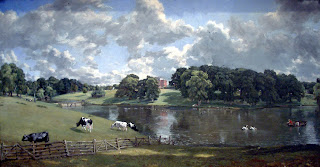But there's a side to Shelley that cannot let go of the world. Even in the lines I just quoted, there is the beautifully simple, concrete reference to the beauty of Keats' poetry: "Which once he made more lovely." The beauty feels real because it's grounded in action (Keats' writing: "he made..."), in time ("once") and in motion ("more lovely").
In "The Cloud," Shelley is at his most transcendent. The cloud is miles removed from human experience: we cannot see or move as it does; it responds to its own action without feelings that we might recognize—remorse, responsibility, fear; unlike us, it "silently laugh[s] at [its] own cenotaph."
In another way, though, this poem shows us Shelley the empirical scientist, looking very closely at the world. The "lashing hail," the sunrise catching the top of a thunderhead, the stars appearing in the breaks of fast-moving nighttime clouds are just a few of the many precise and defined images that he loads the poem with. The poem is about how water vapor condenses into rain, creates thunder and lightning, snow and hail; takes on visible form as clouds; and then vanishes almost without a trace. It is what we were taught in school as (I think) the cycle of transpiration.
No wonder Mary Shelley used Percy as the model for her great scientist Dr. Frankenstein.
The great English painter John Constable, a contemporary of Shelley, spent days, like Shelley, looking at clouds. In hundreds of sketches, we have his records of English weather (Shelley's is probably more Italian, but he did grow up in England).
Constable painted when a new realism was entering "high" art: the clouds he created needed to be real.

Here's a Constable cloud study from 1830, showing clouds over London, from a site called handprint.com.
Constable's works were a major part of his showing England: fertile, wet with Atlantic moisture, a place for the farmwork of the early Industrial Revolution.
This is Constable's Wivenhoe Park from 1816 (the year of Frankenstein), from the Wikipedia article on Constable. It's in the National Gallery of Art (from Wikipedia entry). I love how the clouds are connected with the dark green of the trees and the gleams of the lake, the fatness of the cows, and the speckled shadows on the grass. This is definitely IN the world.

No comments:
Post a Comment